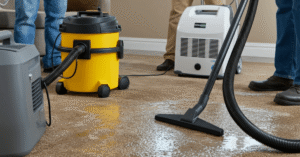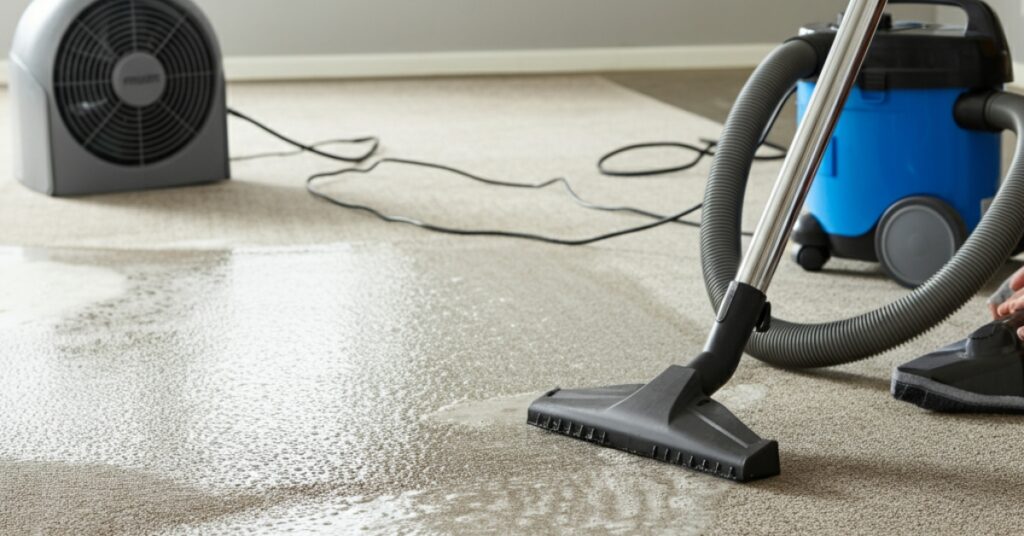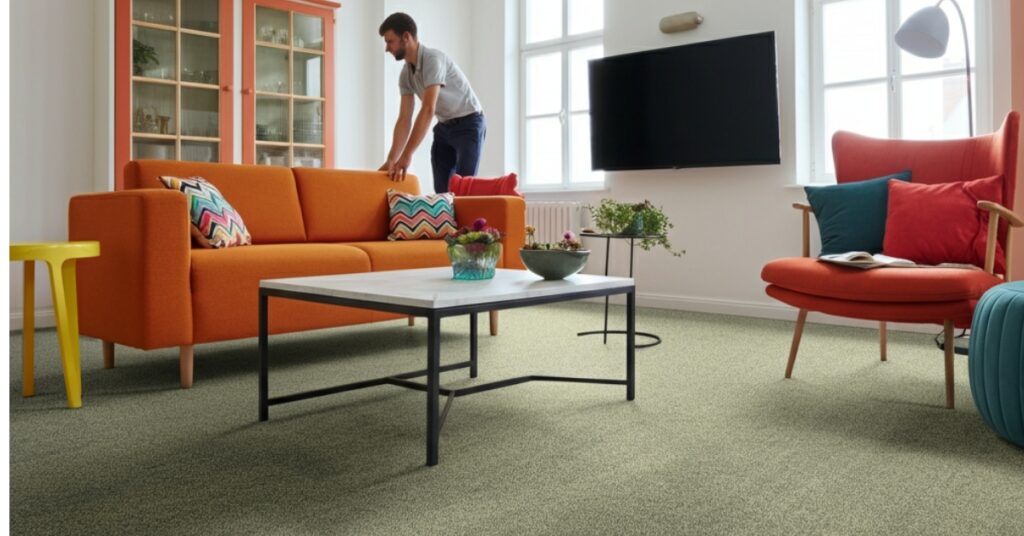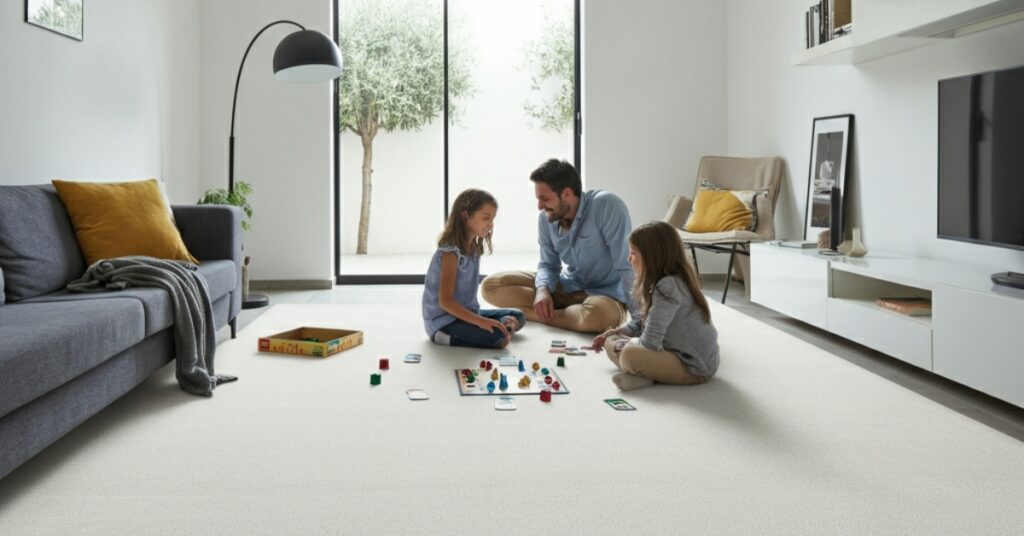As an Amazon Associate, I earn from qualifying purchases.
Matted carpet in high traffic areas is one of the most frustrating problems homeowners face. Whether it’s your hallway, living room entrance, or the space in front of your kitchen sink, learning how to fix matted carpet in high traffic areas can save you hundreds of dollars in replacement costs. Heavy foot traffic, furniture weight, and daily wear gradually compress carpet fibers, creating those unsightly flat spots that make your carpet look worn and aged.
Fortunately, you don’t need professional help to restore your carpet’s appearance. With the right techniques and tools, most homeowners can successfully revive matted carpet fibers and extend their carpet’s lifespan. This comprehensive guide will walk you through proven methods to bring life back to your flattened carpet areas.
Understanding Why Carpet Gets Matted

The Science Behind Carpet Matting
Carpet fibers become matted when they lose their natural resilience and bounce. This happens primarily due to compression from foot traffic, furniture, and accumulated dirt. Over time, the carpet’s backing and padding also compress, making the problem worse.
Different carpet materials respond differently to traffic. Nylon carpets tend to be more resilient, while polyester and olefin carpets mat more easily. Understanding your carpet type helps determine the best restoration approach.
Common Causes of Matted Carpet
Several factors contribute to carpet matting beyond normal foot traffic. Heavy furniture left in one position for extended periods creates permanent indentations. Dirt and debris act like sandpaper, grinding down fibers with each step. Moisture from spills or humidity can also weaken fibers, making them more susceptible to matting.
Pet traffic often accelerates the matting process, especially in areas where pets frequently run or play. Additionally, improper cleaning techniques can push dirt deeper into carpet fibers, contributing to the matting problem.
Essential Tools for Fixing Matted Carpet
Basic Equipment You’ll Need
Start with these fundamental tools: a vacuum cleaner with adjustable height settings, a carpet rake or brush with firm bristles, and a spray bottle for water. These items form the foundation of most carpet restoration projects.
Additionally, gather some ice cubes for furniture indentations, clean towels for moisture control, and a hair dryer or fan for drying. Having these tools ready makes the restoration process more efficient and effective.
Professional-Grade Options to Fix Matted Carpet in High Traffic Areas
For stubborn matting, consider investing in specialized equipment. A carpet grooming rake with metal tines works better than standard brushes on severely matted areas. Steam cleaners can help lift compressed fibers when used correctly.
Carpet cleaning solutions designed for fiber restoration can also improve results. However, always test any cleaning product in an inconspicuous area first to avoid damage or discoloration.
The Ice Method for Furniture Indentations
How Ice Cubes Restore Carpet Fibers
This technique works particularly well for indentations left by heavy furniture. Place several ice cubes directly on the matted area, ensuring complete coverage of the indentation. As the ice melts, it slowly moistens the compressed fibers.
The gradual moisture penetration allows carpet fibers to relax and return closer to their original position. This method works because carpet fibers have memory and will naturally try to return to their manufactured shape when given the right conditions.
Step-by-Step Ice Application Process
Begin by placing ice cubes evenly across the entire indented area. Allow the ice to melt completely, which typically takes 30 minutes to an hour depending on room temperature. Avoid walking on the wet area during this time.
Once the ice has melted, use clean towels to absorb excess water. Then, gently work the damp fibers with your fingers or a carpet brush, encouraging them to stand upright. Allow the area to air dry completely before assessing the results.
Steam and Heat Techniques
Using a Hair Dryer Method
Heat can help restore carpet fiber memory when combined with moisture. Lightly mist the matted area with water, then use a hair dryer on medium heat while brushing the fibers upward. The combination of moisture and heat makes fibers more pliable.
Keep the hair dryer moving to prevent overheating any single area. Work in small sections, brushing fibers as you apply heat. This technique requires patience but often produces excellent results on synthetic carpets.
Steam Iron Approach for Stubborn Areas
For severely matted sections, a steam iron can provide more intensive treatment. Place a damp cloth over the matted area, then hold a steam iron several inches above the cloth. Allow steam to penetrate the carpet for 15-30 seconds.
Remove the cloth and immediately brush the fibers upward while they’re still warm and moist. Be extremely careful not to let the iron touch the carpet directly, as this can cause melting or burning.
Brushing and Raking Techniques
Proper Brushing Direction and Pressure
Always brush against the grain of the carpet to lift matted fibers effectively. Use firm but gentle pressure to avoid damaging the carpet backing. Work in small sections, typically 2-3 square feet at a time, to maintain control and achieve consistent results.
Vary your brushing pattern, using both straight strokes and circular motions. This multi-directional approach helps separate individual fibers and creates a more natural appearance. Take breaks to assess your progress and avoid over-working any single area.
Choosing the Right Brush or Rake
Stiff-bristled brushes work best for most residential carpets. Avoid brushes that are too soft, as they won’t provide enough agitation to lift compressed fibers. Metal-tined carpet rakes are excellent for thick pile carpets but can damage delicate fibers.
Test your chosen tool in an inconspicuous area first. The right brush should lift fibers without pulling them out of the backing. If you notice excessive shedding, switch to a gentler tool.
Deep Cleaning Methods
Vacuuming Strategies for Matted Carpet
Proper vacuuming is crucial when learning how to fix matted carpet in high traffic areas. Adjust your vacuum to the appropriate height setting for your carpet type. Too low can damage fibers, while too high won’t provide adequate suction.
Vacuum slowly, allowing the machine time to lift embedded dirt that contributes to matting. Make multiple passes in different directions, paying special attention to high traffic zones. Empty the vacuum bag or canister frequently to maintain optimal suction power.
Professional Cleaning Solution Application
Sometimes matted carpet requires deep cleaning to remove the dirt and oils that keep fibers compressed. Mix a carpet cleaning solution according to manufacturer instructions, or create a homemade solution using warm water and a small amount of dish soap.
Apply the solution sparingly to avoid over-wetting the carpet. Work it in gently with a brush, then extract as much moisture as possible using towels or a wet vacuum. Allow the carpet to dry completely before assessing the restoration results.
Preventive Measures for High Traffic Areas
Strategic Furniture Placement
Rearrange furniture periodically to prevent permanent indentations. Use furniture pads or coasters under heavy pieces to distribute weight more evenly. Consider rotating your furniture layout seasonally to give carpet fibers time to recover.
In high traffic areas, position furniture to redirect foot traffic patterns when possible. This simple strategy can significantly reduce wear in specific spots and extend your carpet’s overall life.
Regular Maintenance Schedule
Establish a weekly brushing routine for high traffic areas. Spend just five minutes brushing these zones to prevent serious matting from developing. This proactive approach is much easier than attempting major restoration later.
Additionally, maintain a regular deep cleaning schedule. Professional cleaning every 12-18 months, combined with monthly deep vacuuming, keeps carpet fibers healthy and resilient.
When to Call Professionals to Fix Matted Carpet in High Traffic Areas
Recognizing Irreversible Damage
Some carpet matting cannot be reversed with DIY methods. If carpet backing is visible through the fibers, or if large areas refuse to respond to restoration attempts, professional assessment may be necessary. Excessive shedding during restoration attempts also indicates potential permanent damage.
Water damage or mold growth requires immediate professional attention. These conditions can compromise both carpet integrity and indoor air quality, making DIY restoration inappropriate and potentially dangerous.
Cost-Benefit Analysis of Professional Services
Professional carpet restoration typically costs $0.50-$2.00 per square foot, depending on your location and the severity of the matting. Compare this cost to carpet replacement, which ranges from $3-$12 per square foot installed.
Professional services often achieve better results on severely matted carpet and come with guarantees. However, for minor matting in small areas, DIY restoration remains the most cost-effective option.
Alternative Solutions and Products
Carpet Cleaning Products That Help
Several commercial products specifically target matted carpet restoration. Fiber revitalizing sprays can help lift compressed fibers when used as directed. Foam carpet cleaners often provide the right moisture level for effective restoration without over-wetting.
Always read product labels carefully and test in inconspicuous areas first. Some products work better on specific carpet types, so choose products designed for your carpet material.
Temporary and Long-Term Solutions
For immediate improvement before guests arrive, try the quick brush method. Lightly mist matted areas with water, then brush vigorously for instant lift. While temporary, this technique can improve appearance until you have time for thorough restoration.
Long-term solutions include installing carpet runners in high traffic areas, upgrading to more resilient carpet materials during replacement, or considering alternative flooring options for heavily used spaces.
Frequently Asked Questions
1. Can all types of matted carpet be restored?
Not all matted carpet can be fully restored. Natural fiber carpets like wool respond better to restoration attempts than synthetic materials. However, severely damaged carpet with visible backing or missing fibers typically requires replacement.
2. How long does it take to fix matted carpet?
Most DIY restoration projects take 2-4 hours for a typical room, including drying time. Simple brushing techniques may show immediate results, while ice or steam methods require several hours for complete treatment and drying.
3. Will fixing matted carpet damage it further?
Proper restoration techniques won’t damage carpet when done correctly. However, aggressive brushing, excessive heat, or over-wetting can cause additional problems. Always start with gentle methods and test in hidden areas first.
4. How often should I treat matted carpet in high traffic areas?
Prevention is key to managing matted carpet. Brush high traffic areas weekly and perform deeper restoration monthly as needed. Address matting early to prevent permanent damage and make restoration easier.
5. Does carpet age affect restoration success?
Yes, newer carpets generally respond better to restoration efforts. Older carpets may have weakened fibers that break during treatment. Carpets over 10 years old may benefit more from professional assessment than DIY restoration.
6. Can I use a regular hair brush instead of a carpet brush?
While possible, regular hair brushes aren’t ideal for carpet restoration. They’re typically too gentle for effective fiber lifting and may break under the pressure needed for matted carpet. Invest in proper carpet brushes for best results.
Final Verdict
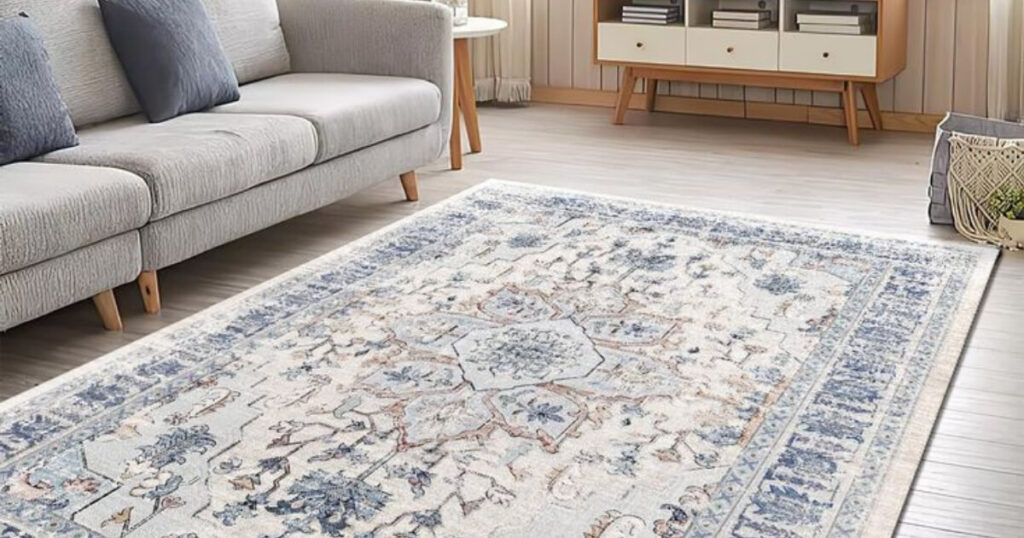
Learning how to fix matted carpet in high traffic areas empowers you to maintain your home’s appearance while saving money on premature carpet replacement. Start with simple techniques like regular brushing and ice cube treatments before progressing to more intensive methods. Remember that prevention through regular maintenance is always easier than restoration after severe matting occurs.
Take action today by assessing your high traffic areas and choosing the appropriate restoration method for your situation. With patience and the right approach, you can successfully revive your matted carpet and enjoy a fresh, attractive floor covering for years to come.
As an Amazon Associate, I earn from qualifying purchases.

